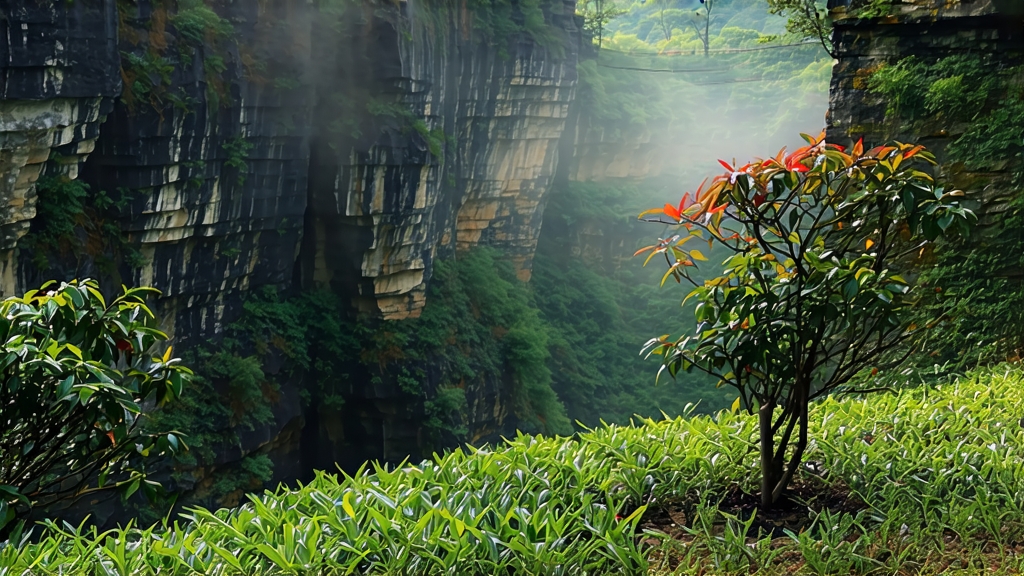
When Chinese tea lovers whisper about “drinking a mountain,” they are usually talking about Wuyi Da Hong Pao. Literally “Big Red Robe,” this oolong is less a beverage than a liquid landscape—one that carries the taste of mineral cliffs, pine smoke, and river mist in every sip. Its story begins in the vertiginous Wuyi Mountains of northern Fujian, a UNESCO dual World Heritage site where 400-million-year-old granite spires rise above the Nine-Bend River. Here, tea bushes do not grow in tidy hedges; they cling to narrow ledges, their roots inching into crevices once reserved for eagles. The locals call such tea “yancha,” rock tea, and Da Hong Pao is its undisputed monarch.
The legend that gave the cultivar its romantic name is still told by boatmen poling bamboo rafts through the river’s hair-pin turns. In the late Ming dynasty, a scholar on his way to the imperial exams fell ill at the foot of Tianxin Cliff. Monks from a nearby temple picked leaves from six ancient bushes growing so high that monkeys were trained to harvest them. The restorative brew revived the scholar, who went on to place first in the exams. To express gratitude, the emperor dispatched officers to drape the bushes in scarlet silk—“big red robes” that flapped against the grey stone like flames. Whether myth or marketing, the image stuck, and those six mother trees, now protected by armed guards and surveillance cameras, still stand outside the Dragon Spring Temple. Since 2006 their leaves have been legally off-limits; even the caretakers are forbidden to pluck them. What circulates today are cuttings propagated in the 1980s and 1990s, collectively called “pure-specimen Da Hong Pao” or qizhong, “strange cultivar,” a genetic echo of the originals.
Botanically, Da Hong Pao belongs to the Wuyi qi-cong family, a group of bushes that mutated on site rather than being transplanted. Growers separate it into three commercial tiers. The first, “mother-tree tea,” exists only in 20-gram tins locked in provincial vaults; when a few grams surface at auction, prices rival those of vintage Burgundy. The second, “pure-specimen,” comes from first-generation cuttings grown in the original 60-square-kilometer core scenic zone. The third, “blended Da Hong Pao,” skillfully marries leaves from related cultivars such as Rou Gui, Shui Xian, and Tie Luo Han to recreate the signature “rock rhyme” at an accessible price. Far from being inferior, the blends are where most master roasters display their art, balancing floral top notes against a basal mineral depth that the Chinese describe as “the bones of the mountain.”
Making Da Hong Pao is a duet between nature and fire. Picking starts in late April when three half-mature leaves and a dormant bud are snipped in a “fish-hook” shape. The pluck must be neither too gentle—bruising triggers premature oxidation—nor too rough, lest the leaf edges tear unevenly. After a brief solar withering, the leaves are shaken in flat bamboo drums in a process called yaoqing, “wavering green.” Each toss bruises the margins against the veins, initiating oxidation only at the edges while the midrib stays green. The rhythm—shake, rest, shake—continues through the cool mountain night until the leaves emit a sharp apple-peel fragrance. At 3 a.m., when the air is thickest with negative ions, the master halts oxidation with a 280 °C tumble in electric woks. The kill-green lasts less than three minutes, just long enough to set the jade center while locking in the scarlet rim.
What follows is the step that separates Wuyi craftsmen from all other oolong makers: charcoal roasting. The semi-dried leaves are loaded into 50-kilogram rattan baskets and lowered into a brick kiln fired by local hardwood. The first roast, “water removal,” bakes at 120 °C for eight hours, driving moisture from the stem. After a fortnight of rest, the leaves return to the kiln for a second, cooler roast whose temperature is judged by the master pressing his bare palm against the bamboo wall—an act that requires calluses built over decades. A third, even gentler roast may follow, each cycle deepening the amber